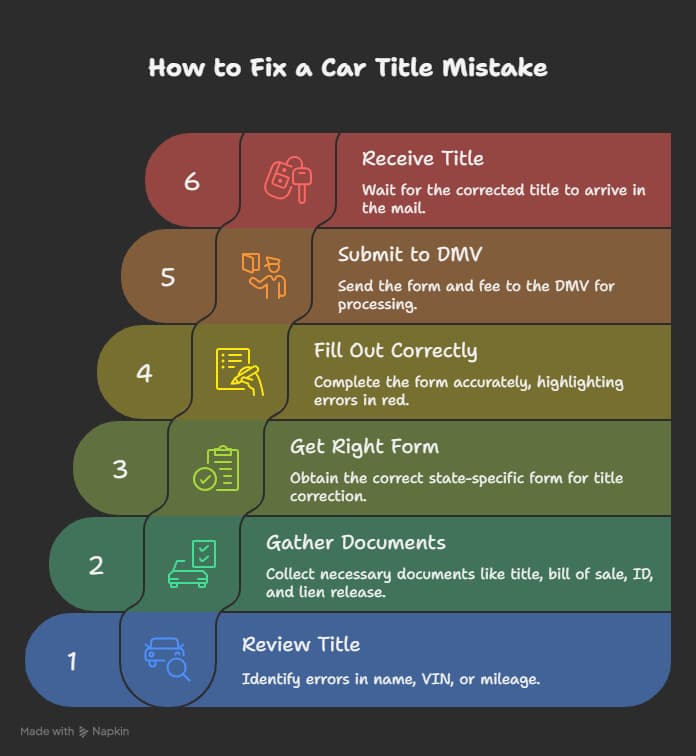
How To Fix Errors on Your Car Title Before Selling?
Mistakes on a car title can stop a sale cold. A wrong name, odometer number, or VIN creates delays and legal risks. Sellers face these issues often, especially in private deals. This guide explains how to spot and fix errors. It covers steps for all states and vehicle types, from standard cars to RVs and Kei trucks.
Key Takeaways
Common errors and how to spot them early.
Step-by-step fixes with state examples.
Prevention tips to avoid repeats.
Rules for liens, disclosures, and transfers.
What Is a Car Title and Why Do Errors Matter When Selling?
A car title acts as the legal proof of ownership for a vehicle. It holds key facts. These include the make, model, year, Vehicle Identification Number, owner name, address, odometer reading, and any liens from financial institutions. A title error means any wrong detail on the paper. This could be a misspelled name or incorrect mileage.
Errors block title transfer during sales. They raise flags in systems like the National Motor Vehicle Information System. A corrected title on a car replaces the bad one after fixes. It lets the sale go forward.
State offices demand perfect matches. The Department of Motor Vehicles or Secretary of State checks everything for registration. Wrong odometer hints at tampering. This leads to fines or rejected papers.
Classic cars or military Humvees suffer more. Errors mess with insurance or special checks. Private sellers must fix before payment. Buyers want clean docs. Errors make them walk away.
Undisclosed liens bring big trouble. Selling with one open can mean lawsuits. In bad cases, it leads to jail if seen as fraud. Get a lien termination statement first.
Disclose defects in writing on the bill of sale. Hiding problems breaks laws. You can sell with faults if noted. Omission opens you to claims.
Errors cost time and money. A delayed sale means storage fees or lost interest. Buyers may demand discounts. Fix early to keep control.
How Do You Identify Common Title Errors When Selling?
You find title errors by checking the document against the vehicle and papers. Use good light. Compared to the bill of sale and ID. Look for name spells, odometer reading, signatures, dates, VIN, lined sections, or liens. Include vehicle details like body style for RVs.
Run NMVTIS or CoPilot scans. They show mileage discrepancies or title jumping. If a buyer skips transfer, it leaves you on the hook.Errors vary by type. Name or address wrongs come from quick writes. Match to driver's license. Odometer issues hit imports like Kei trucks. Kilometers turn to miles wrong.
Signature errors void transfer. Sign in the buyer spot by mistake. RVs have more lines. Dates off suggest fraud. VIN off by one digit alerts systems. Needs law enforcement check.Lined info without approval looks fake. Lien wrongs miss lien termination statement after payoff. Specialty rides have extras. Wrong body style stops street legal for UTVs. Old models lack odometer spots.
Title jumping skips steps. Illegal in flips. Private sales need care. Require payment full before sign. Include bill of sale with condition, mileage, as-is if used.Verify buyer ID. Prevent scams. Use the 30-60-90 rule. 30-minute drive. Hit 60 mph. Check 90-degree turns. Spots hidden faults. Store title safe. Review on get from past deals.
How to Fix a Written Mistake on a Car Title When Selling: Step-by-Step Guide

Correcting a mistake on a car title during a sale requires proper forms, ID, and state-specific submission. Each state’s process varies slightly, but the overall steps remain similar. Avoid using correction fluid or crossing out errors this can void the document.
Step 1: Review the Title for Errors
Look for misspelled names, wrong VINs, or incorrect mileage. Note exactly where the error appears before contacting your DMV.
Step 2: Gather Required Documents
You’ll typically need:
Original car title
Bill of sale
Government-issued ID
Proof of correction (e.g., purchase paperwork or lien release)
Lien termination statement, if applicable
Step 3: Obtain the Correct Form
Most states require one of these:
Statement or Affidavit of Correction (for name or address errors)
Duplicate Title Application (for serious errors or damage)
Common examples:
Massachusetts: Use Form RMV-5, attach the title and correction proof, and mail it to the Registry of Motor Vehicles.
Indiana: Use Form 55582 through the Bureau of Motor Vehicles; VIN verification may be required by a dealer or officer.
Step 4: Complete the Form Accurately
Use black or blue ink only. Circle the incorrect section lightly in red (if allowed) and note the correction nearby. Include your signature and the date.
Step 5: Submit to the DMV or Licensing Office
Submit your packet in person or by mail with any applicable title correction fee ($10–$50). Some states offer online submission and digital notarization for faster processing.
Step 6: Wait for the Updated Title
Processing takes 2–4 weeks on average. Review your new title carefully once it arrives to ensure all corrections are complete.
Extra Tips:
Dealer errors: Contact the dealer immediately; they must fix and refile at no charge.
Out-of-state titles: Follow the issuing state’s DMV instructions.
Digital services: Online platforms can assist with packet prep, title recovery, and verification for imports or motorcycles.
No whiteout or erasures: These invalidate the document.
State-Specific Forms and Rules for Fixing Car Title Errors When Selling
Each U.S. state has its own forms, fees, and submission methods for correcting title errors during a vehicle sale. Most allow in-person or mail submissions with the original title, valid ID, and a bill of sale explaining the correction. Always check your state’s DMV or motor vehicle agency for the latest requirements, as rules and fees change regularly.
California
Form Required: REG 101 Statement of Error or Erasure
Submission: Mail with the California Certificate of Title, ID, and correction explanation.
Fee: $23 correction charge.
VIN Verification: May be required by a DMV employee or licensed verifier.
Processing Time: 10–14 days.
Tip: Circle the error lightly in red and attach a note of correction.
New Jersey
Form Required: Notarized Affidavit of Correction
Submission: Send to the New Jersey Motor Vehicle Commission with the title, ID, and bill of sale.
Processing Time: Around 10–14 days.
Extra Step: Notify the MVC of the sale within 10 days using Form OS/SS-31 to avoid liability.
Penalty: Failing to transfer titles within 10 days can lead to $100+ fines.
Indiana
Form Required: Form 55582 Application for Certificate of Title Correction
Submission: File at a BMV branch or by mail.
Fee: Standard title correction fee (varies by county).
Processing Options: Expedited service available for an additional fee.
Tip: Circle the error, provide supporting proof (bill of sale, lien release, or ID), and sign clearly in black or blue ink.
Utah
Form Required: Form TC-656 Vehicle Application for Correction or Transfer
Base Fee: $6 title transfer; counties may add emissions or inspection fees.
Private Sales: Must include signed title, odometer disclosure, and bill of sale emissions certificate required in designated counties.
Submission: In person is standard, though some offices accept mail for minor corrections.
Note: A bill of sale alone is not valid without the signed title.
Virginia
Procedure: Both parties must appear at the Virginia DMV for title corrections or transfers.
Special Cases: Power of Attorney accepted for absent sellers or buyers.
Michigan
Form Required: TR-205 Affidavit of Correction
Submission: DMV office or by mail with valid driver’s license or ID.
Tip: Ensure all signatures match the title record exactly to prevent rejections.
Other States & General Tips
Cross-state vehicles must follow the original title issuer’s rules.
NMVTIS (National Motor Vehicle Title Information System) automatically flags irregularities for verification.
For specialty vehicles or UTVs, use the same correction forms but attach modification affidavits where required.
Online services can compile and prefill state-specific packets to simplify multi-state or fleet submissions.
Pro Tip: Always verify the exact fee and form version on your state’s DMV site before mailing — small errors can delay processing by weeks.
How to Prevent Future Title Errors When Selling: Proactive Strategies
Avoiding title mistakes when selling your car comes down to accurate documentation, verified details, and clear communication. A few proactive habits can save weeks of delays or even legal trouble.
1. Verify All Vehicle Details Before Listing
Match the VIN across all locations dashboard, door frame, and engine block.
Check NMVTIS records (National Motor Vehicle Title Information System) to ensure the title isn’t branded or duplicated.
Confirm the odometer reading and record it exactly on both the title and bill of sale.
2. Prepare a Complete Bill of Sale
A proper bill of sale should include:
Buyer and seller names with signatures
Sale date, price, VIN, mileage, and vehicle condition
Any known defects or “as-is” status disclosures
Buyer’s photo ID verification at the time of signing
This protects both parties and helps avoid disputes or fraud allegations later.
3. Manage Liens Before the Sale
Pay off any existing loan balance before listing the vehicle.
Obtain a Lien Termination Statement or letter from your lender.
Selling with an open lien is considered fraud and may carry legal penalties.
4. Double-Check Paperwork Before Submission
Sign and date all title fields clearly no whiteout or cross-outs.
Use black or blue ink only.
Review the buyer’s name, address, and spelling before mailing or submitting.
5. Protect Yourself in Private Sales
Always complete the title transfer immediately after payment.
Avoid leaving the buyer’s section blank doing so risks liability if the car is resold without transfer.
Never hide damage or mechanical issues; full disclosure prevents lawsuits.
6. Consider Long-Term Ownership Solutions
For collectors or multi-vehicle owners, forming a Montana LLC can streamline registration and avoid repeat title updates.
Montana LLC registration provides permanent plates and eliminates state sales tax for qualifying vehicles like RVs, motorcycles, and Humvees.
7. Build Smart Selling Habits
Store all titles and sale records in a secure location.
Review past transactions to spot recurring documentation issues.
Follow the “30-60-90” rule before selling 30 minutes of driving, 60 mph speeds, and 90-degree turns reveal hidden mechanical issues before ownership changes.
Street Legal Hookup – Why We’re the Best Choice
At Street Legal Hookup, you access a fully online vehicle registration and titling service that streamlines DMV processes for owners in all 50 states, delivering legal compliance and major cost savings without hassle.
Proven Expertise: Our team brings years of specialized knowledge in complex titling, from lost documents to imported Kei trucks and military Humvees.
Flat-Fee Pricing: Secure transparent costs averaging $995, covering everything with no hidden fees or residency demands.
Montana LLC Advantage: Legally bypass sales tax and inspections, helping clients save $5,000 to $15,000 on RVs, motorcycles, and specialty vehicles.
Secure Online Platform: Upload documents safely and track progress in real-time through a user-friendly dashboard for complete control.
Money-Back Guarantee: Full refund if services don't meet expectations, supported by successful outcomes for thousands of vehicles annually.
Specialty Focus: Convert off-road UTVs, ATVs, and dirt bikes to street-legal status with bundled expertise and no emissions requirements.
Rapid Turnaround: Receive permanent plates shipped in as little as three business days, minimizing delays for collectors and travelers.
Client Success Stories: Real feedback from RV owners and enthusiasts highlights stress-free transfers and tax relief in high-burden states.

Frequently Asked Questions
What is an affidavit of correction on a car title?
An affidavit of correction is a sworn statement explaining title errors, like a misspelled name or wrong date. Notarize it, attach to the title, and submit to your DMV with ID. It supports title correction without a full duplicate, often costing a small fee. Online services file this digitally nationwide.
How do I fix a written mistake on my car title when selling in NJ?
In New Jersey, complete an Affidavit of Correction, notarize, and mail or bring to the Motor Vehicle Commission with the title, bill of sale, and ID. Pay the fee; get a corrected title in 10–14 days. Avoid title jumping by registering properly first.
What is the title correction form in Indiana?
Indiana uses Form 55582 for title correction. Download from BMV site, fill details, circle errors, and submit in-person or mail with supporting docs. Title correction fee applies; VIN fixes need verification.
What is required to transfer a car title in Utah?
Utah needs TC-656 form, original title, odometer reading disclosure, bill of sale, emissions (if applicable), and ID. Fix errors first via correction app; pay fees at DMV.
What is a corrected title on a vehicle?
A corrected title is a new Duplicate Title issued after fixing errors, replacing the faulty one. It shows accurate info for title transfer, preventing legal complications.
What happens if a title company makes a mistake?
If a title company errs (rare in sales), contact them for an amendment. Provide proof; they issue a correction. For sales, delay closing until fixed to avoid disputes.
Conclusion
You end the fix by going over spots, steps, state forms, and prevent. Check the new title perfect for transfer.
Process includes identifying, correct, rules, avoid for sales any state. Fixing written mistakes on car title when selling makes bad deals good. Spot to forms or LLC keeps legal smooth all places.
Start your title correction with Street Legal Hookup flat-fee online service today.



